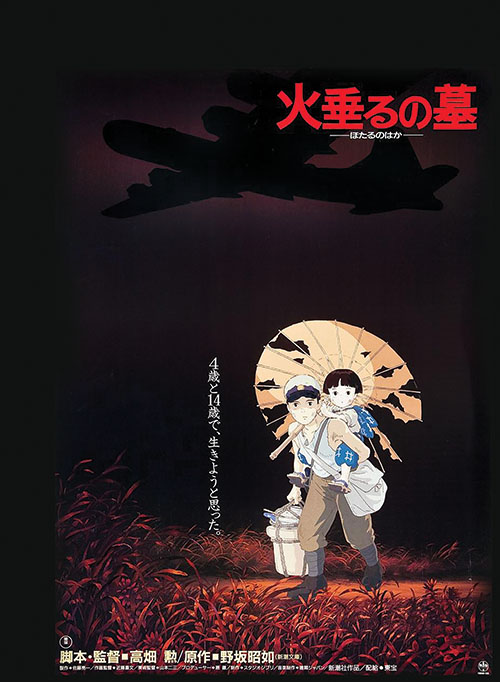“September 21, 1945. That was the night I died.”
So says the spirit of 14-year-old Seita as he gazes upon his own wasted body, clad in ragged clothes and propped against the pillar of a railway station, ignored by the bustle of people around him as he takes his final shallow breaths. “Setsuko,” he murmurs, and dies. A railroad employee prepares to carry away his body, but not before noticing Seita’s only possession: a small tin can that once held fruit drops. The employee takes the can to the edge of the station and pitches it into a field. The employee turns away. Then something remarkable happens: the lid of the can falls off and several fireflies emerge, as well as the image of a little girl about four years old. It is the spirit of Seita’s lost sister Setsuko.
Grave of the Fireflies tells, through flashback, the story of how Seita (voiced by Tsutomu Tatsumi) and Setsuko (Ayano Shiraishi) lived and died in the final months of World War II. It is done in the distinctive Japanese animation style of anime, with its heightened depiction of characters’ facial expressions—an artistic choice that imbues the film with stunning emotional power.
The flashback begins with waves of B-29 Superfortresses flying over the children’s hometown of Kobe, Japan, raining incendiary bombs upon terrified inhabitants as they scramble to reach the relative safety of air raid shelters. After the raid, most of the city lies in ruins, the children’s mother has been fatally burned, and their home immolated. Seita and Setsuko go to live with an aunt, but she resents their presence. She trades their mother’s valuable kimonos for rice, then appropriates most of the rice for herself and her family, justifying the choice by sneering that Seita does nothing to help the war effort. Seita soon leaves with Setsuko and they make a home for themselves in a small, unused shelter dug into a hillside. Setsuko brings along a treasured tin of fruit drops that also contains a few marbles, coins, and a ring once worn by their mother.

Like any four-year-old, Setsuko sometimes cries and plaintively complains, but Seita is a good protector who works hard to make her happy. For a time, they are both content, playing together on the beach, finding enough food to get by, and marveling at the dozens of fireflies that illuminate their cave at night. But soon they are reduced to eating frogs and thin rice gruel. Setsuko begins to weaken, and Seita desperately tries to find enough food to keep them going; the adults around them—preoccupied with their own desperate straits—offer no help. Finally Seita carries Setsuko to a doctor, who diagnoses her condition as malnutrition from diarrhea.
Seita asks for some medicine. “All she needs is some food,” the doctor replies impassively.
The response enrages Seita. He asks, “How am I supposed to get food?”
Eventually Seita makes it to a bank and is able to withdraw 3,000 yen from his mother’s account, enough to buy plenty of food for himself and his sister. In the process, he learns to his astonishment that Japan has surrendered. But by the time he returns to the cave Setsuko is near death, too weak to eat anything but a morsel of watermelon. “It’s good,” she says, and falls asleep.
“She never woke up,” Seita’s spirit tells us.
Seita holds Setsuko’s lifeless body, then goes off to buy some charcoal for her cremation. Along the way he sees other children, well-clad and happy, returning to their homes. The camera cuts to the abandoned shelter as the image of Setsuko appears and disappears, delightedly at play like any four-year-old. Then Seita places Setsuko in a straw coffin and cremates her body on a hilltop over the city. Night comes, and with it hundreds of fireflies.
“The next morning I put some of Setsuko’s ashes in the candy tin and climbed down the hill,” mourns Seita. “I never went back to the shelter again.”
As Seita sits near his sister’s funeral pyre, the scene fades into the present, with Seita and Setsuko both in the afterlife. Seita’s spirit is sitting on a park bench. As Setsuko’s spirit calls out her brother’s name, she emerges from the night and runs to join him. He hands her a cherished rag doll and the beloved tin of fruit drops. “Time for bed,” he says, and she snuggles close to him and falls asleep. For a moment, Seita’s spirit stares straight at the viewer. We see the spirits of brother and sister together on the bench, forever reunited, surrounded by fireflies, and looking down upon the modern city of Kobe.
It would be easy to read Grave of the Fireflies as an antiwar film—but that interpretation is firmly denied by director Isao Takahata, and Akiyuki Nosaka, who wrote the story on which it is based. In 1945, Nosaka was, like Seita, 14 years old and charged with the care of his 16-month-old sister, who, like Setsuko, died of malnutrition. Nosaka blamed himself for his sister’s death. He conceived the story as a personal apology to her and, in some measure, a catharsis of his guilt. Nor is the film a statement about war. That would imply a generalization, and Grave of the Fireflies is firmly specific. Seita is the brother Nosaka wishes he could have been. And his story is an elegy for a specific infant sister, lost long ago. ✯





